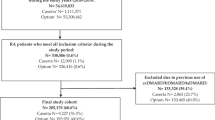Abstract
To analyze the biologics usage and expenditure for the treatment of patients with rheumatoid arthritis (RA) in each prefecture throughout Japan using the national open database, the Ministry of Health, Labour and Welfare of Japan disclosed; in Oct 2016, the data of the top 30 most-frequently prescribed drugs during a 1-year period from April 2014 to March 2015 in each prefecture in Japan, along with the patients’ age and sex. Seldom-used drugs were excluded. We picked up only biologics for the present study. The total expenditure on biologics used in each prefecture was correlated with the population thereof. However, there was a big difference, up to ~ twofold, in the average expenditure used for an RA patient: highest in Toyama and lowest in Wakayama. There was also a big difference, ~ 4.5-fold, in the number of rheumatologists/1000 RA patients, highest in Kyoto and lowest in Aomori. The average expenditure used for an RA patient was correlated with the number of rheumatologists in the western part of Japan. Etanercept seemed to be used most frequently to Japanese RA patients followed closely by infliximab. Abatacept was used more frequently to the elderly than other biologics. There was a big difference in the number of rheumatologists and expenditure on biologics for the treatment of an RA patient among prefectures in fiscal 2014. Factors that brought this unevenness need to be scrutinized for universal implementation of good RA care throughout Japan, where there are uniform health insurance system and free access to rheumatologists.




Similar content being viewed by others
References
National Database of Health Insurance Claims and Specific Health Checkups of Japan. http://www.mhlw.go.jp/stf/seisakunitsuite/bunya/0000139390.html. Accessed 12 Oct 2016
Medical data vision. https://www.mdv.co.jp/. Accessed 12 Oct 2016
Nagai M, Ohta A, Nishina M et al (2005) Analysis of the electronic clinical database of patients with intractable diseases receiving financial aid for treatment. Research Committee on Epidemiology of Intractable Diseases Ministry of Health, Labour and Welfare, Japanese Government
Takahashi H, Nakamura K, Kaneko F et al (2011) Analysis of psoriasis patients registered with the Japanese Society for Psoriasis Research from 2002 to 2008. J Dermatol 38:1125–1129
Miyamoto S, Sugimura Y, Kasiwagura T et al (2015) Evaluation for treatment of rheumatoid arthritis patients in AORA cohort. Clin Rheumatol 27:135–145
Ishigaki S (2007) Activities of Asunaro-Kai, parent association for children with juvenile idiopathic arthritis. Saishin-Igaku 62:1083–1088
Population data that the Bureau of Statistics, the Ministry of Internal Affairs and Communications. http://www.e-stat.go.jp/SG1/estat/List.do?lid=000001132435. Accessed 12 Oct 2016
Study Committee on Rheumatoid Arthritis and Allergy, the Section of Disease Control, the Health Sciences Council. http://www.mhlw.go.jp/stf/houdou/2r9852000001nfao-att/2r9852000001nfdx.pdf. Accessed 12 Oct 2016
Basic Survey on Wage Structure (2014) By the Ministry of Health, Labour and Welfare. http://www.mhlw.go.jp/toukei/itiran/roudou/chingin/kouzou/z2014/index.html. Accessed 12 Oct 2016
Author information
Authors and Affiliations
Contributions
YK designed the study, and wrote the initial draft of the manuscript. SM instructed to begin this study and contributed to analysis and interpretation of data, and assisted in the preparation of the manuscript. All authors have contributed to data collection and interpretation, and critically reviewed the manuscript. All authors approved the final version of the manuscript, and agree to be accountable for all aspects of the work in ensuring that questions related to the accuracy or integrity of any part of the work are appropriately investigated and resolved. YK does not have any external editing support. SM does not have any external editing support. YK has nothing to disclose any relationship with pharmaceutical agencies over the past 3 years. SM has nothing to disclose any relationship with pharmaceutical agencies over the past 3 years in relation with this study.
Corresponding author
Ethics declarations
Conflict of interest
The authors declare that they have no competing interests.
Financial support
None.
Funding
None.
Ethical approval
This article does not contain any studies with human participants or animals performed by any of the authors.
Rights and permissions
About this article
Cite this article
Kamata, Y., Minota, S. Wide difference in biologics usage and expenditure for the treatment of patients with rheumatoid arthritis in each prefecture in Japan analyzed using “National Database of Health Insurance Claims and Specific Health Checkups of Japan”. Rheumatol Int 38, 663–668 (2018). https://doi.org/10.1007/s00296-017-3900-5
Received:
Accepted:
Published:
Issue Date:
DOI: https://doi.org/10.1007/s00296-017-3900-5




